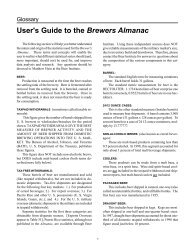The Tax Burden on the Brewing Industry - The Beer Institute
The Tax Burden on the Brewing Industry - The Beer Institute
The Tax Burden on the Brewing Industry - The Beer Institute
Create successful ePaper yourself
Turn your PDF publications into a flip-book with our unique Google optimized e-Paper software.
GLOBAL INSIGHT, INC. AND THE PARTHENON GROUP<br />
Technical Note: Comparis<strong>on</strong> to Prior Study<br />
<str<strong>on</strong>g>The</str<strong>on</strong>g> 2003 tax burden <strong>on</strong> beer is 41%, whereas it was computed to be 44% in <strong>the</strong> last study examining 1997 data. This is not<br />
due to a reducti<strong>on</strong> in <strong>the</strong> relative burden <strong>on</strong> beer versus o<strong>the</strong>r items in <strong>the</strong> ec<strong>on</strong>omy. Instead, this change reflects two shifts<br />
affecting measured tax burdens in <strong>the</strong> US ec<strong>on</strong>omy: 1) genuine reducti<strong>on</strong>s in tax rates <strong>on</strong> all pers<strong>on</strong>al income and corporate<br />
profits; and 2) a redefiniti<strong>on</strong> or reclassificati<strong>on</strong> by <strong>the</strong> US Department of Commerce of important state-local receipts from<br />
“taxati<strong>on</strong>” to n<strong>on</strong>-tax revenue. <str<strong>on</strong>g>The</str<strong>on</strong>g> former change, legislated tax cuts, provides by far <strong>the</strong> dominant explanati<strong>on</strong> for <strong>the</strong> reducti<strong>on</strong><br />
in both burdens.<br />
According to current definiti<strong>on</strong>s and data, total taxes as a percent of GDP are 3 percentage points lower, 25.5% in 2003 versus<br />
28.5% in 1997. Federal taxati<strong>on</strong> fell from 19.4% to 16.6% of GDP, while state plus local taxati<strong>on</strong> fell from 9.2% to 8.9%. On<br />
<strong>the</strong> federal side, <strong>the</strong> greatest change was with regard to pers<strong>on</strong>al income taxati<strong>on</strong>, where <strong>the</strong> effective rate <strong>on</strong> all taxable income<br />
was reduced from 21.7% to 18.8%. <str<strong>on</strong>g>The</str<strong>on</strong>g>se tax rates, and related rates, are used to compute <strong>the</strong> total burden <strong>on</strong> all producers,<br />
suppliers, wholesalers, and retailers.<br />
A minor reducti<strong>on</strong> between <strong>the</strong> 1997 and 2003 studies in <strong>the</strong> measured taxati<strong>on</strong> of beer also occurs because federal grants to<br />
states were previously counted in official state-local “tax revenues.” <str<strong>on</strong>g>The</str<strong>on</strong>g>y are now c<strong>on</strong>sidered, appropriately, to be n<strong>on</strong>-tax<br />
receipts. This did not have a material effect <strong>on</strong> <strong>the</strong> beer tax burden calculati<strong>on</strong> because <strong>the</strong> aggregate tax/GDP ratio was <strong>on</strong>ly<br />
used to compute <strong>the</strong> tax burden <strong>on</strong> beer value-added that could not be o<strong>the</strong>rwise specifically attributed to wages, profits, or sales<br />
revenues of <strong>the</strong> brewing industry and its suppliers. That is, specific income and payroll tax rates were assessed against wages,<br />
profit tax rates against profits, and sales or excise tax rates against revenues or producti<strong>on</strong> volumes. However, <strong>the</strong> earlier<br />
definiti<strong>on</strong>—which is clearly illogical when assessing business burdens—would have artificially boosted <strong>the</strong> assessment of taxati<strong>on</strong><br />
<strong>on</strong> <strong>the</strong> rest of <strong>the</strong> ec<strong>on</strong>omy for comparis<strong>on</strong> to <strong>the</strong> beer tax burden. <str<strong>on</strong>g>The</str<strong>on</strong>g> current definiti<strong>on</strong> avoids <strong>the</strong>se problems.<br />
Finally, “domestic spending” was used to compare <strong>the</strong> tax burden <strong>on</strong> beer relative to <strong>the</strong> rest of <strong>the</strong> ec<strong>on</strong>omy. <str<strong>on</strong>g>The</str<strong>on</strong>g> previous study<br />
used GDP. <str<strong>on</strong>g>The</str<strong>on</strong>g> tax burden <strong>on</strong> beer equals beer industry taxes divided by c<strong>on</strong>sumer spending <strong>on</strong> beer. <str<strong>on</strong>g>The</str<strong>on</strong>g>refore <strong>the</strong> burden <strong>on</strong><br />
all o<strong>the</strong>r goods and services should be measured relative to total spending in <strong>the</strong> US ra<strong>the</strong>r than US output (GDP). Technically,<br />
domestic spending equals GDP plus imports minus exports. In 2003, domestic spending was $11,502 billi<strong>on</strong>, 4.5% higher than<br />
GDP of $11,004 billi<strong>on</strong>. On this correct basis, <strong>the</strong> total tax burden nati<strong>on</strong>ally for all good and services spending including beer<br />
was 24.4%, versus 25.5% if measured with GDP in <strong>the</strong> denominator. Subtracting <strong>the</strong> more-heavily taxed beer sector to estimate<br />
<strong>the</strong> burden <strong>on</strong> all o<strong>the</strong>r goods and services reduces both of <strong>the</strong>se ratios by 0.2%. Thus, <strong>the</strong> final comparis<strong>on</strong> of <strong>the</strong> tax burden <strong>on</strong><br />
beer of 40.8% was compared to total domestic spending minus beer of 24.2% (24.4% -0.2%). This amounts to <strong>the</strong> burden <strong>on</strong><br />
beer being more than 68% above <strong>the</strong> tax rate <strong>on</strong> <strong>the</strong> rest of <strong>the</strong> ec<strong>on</strong>omy.<br />
4





